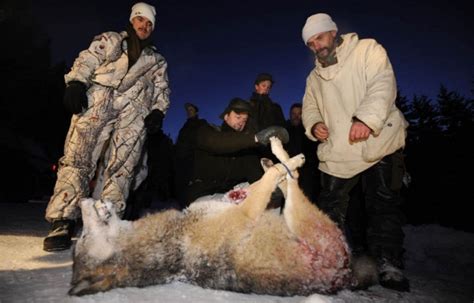How An Eskimo Kills A Wolf
Ronan Farrow
Apr 03, 2025 · 3 min read

Table of Contents
How an Eskimo Kills a Wolf: Traditional Hunting Methods and Survival
The question of "how an Eskimo kills a wolf" isn't a simple one. It's a question that delves into the rich tapestry of Inuit culture, their deep understanding of the Arctic environment, and their ingenious survival techniques. It's crucial to understand that this wasn't a casual act, but a vital part of their subsistence and survival in a harsh, unforgiving landscape. The methods employed reflected respect for the animal and a deep understanding of its behavior. Let's explore the nuanced approaches these skilled hunters used.
Traditional Inuit Hunting Techniques for Wolves
Inuit wolf hunting wasn't a reckless endeavor. It required patience, skill, and meticulous planning. Several methods were employed, often dependent on the time of year, available resources, and the specific terrain:
1. Traps and Snares: The Patient Hunter's Approach
- Pitfalls: These cleverly concealed pits, often camouflaged with snow and brush, were designed to trap wolves. The depth and construction ensured the wolf couldn't easily escape. This method required significant effort in preparation but was highly effective.
- Snares: Strong, expertly crafted snares, made from materials readily available in the Arctic environment, were strategically placed along wolf trails or near known hunting grounds. These snares were designed to restrain the wolf, allowing the hunter to approach and dispatch it safely.
2. Hunting with Dogs: A Team Effort
- Teamwork: Inuit hunters often utilized teams of trained sled dogs to pursue and corner wolves. The dogs, themselves skilled hunters, would harass and tire the wolf, creating an opportunity for the hunter to make a kill with a spear or other weapon. This was a dangerous and demanding method, relying heavily on the dogs' bravery and the hunter's expertise.
3. Spear Hunting: Precision and Skill
- Close-Quarters Combat: In some cases, Inuit hunters would engage in close-quarters combat with spears. This required exceptional bravery, skill, and a deep understanding of wolf behavior to predict its movements and deliver a precise, fatal blow. This was undoubtedly a high-risk approach.
4. Understanding the Environment: The Key to Success
The success of any wolf hunting method depended heavily on the hunter's intimate knowledge of the environment. Understanding wolf behavior, tracking skills, and knowledge of the terrain were paramount. Inuit hunters meticulously studied wolf patterns, learning their travel routes and hunting strategies. This knowledge was passed down through generations, ensuring the continuation of their hunting traditions.
The Importance of Respect: Beyond the Hunt
It's vital to understand that for the Inuit, wolf hunting was not simply about killing. It was a deeply respectful act, acknowledging the wolf's place in the ecosystem and demonstrating gratitude for its contribution to their survival. Every part of the wolf was utilized—its fur for clothing, its meat for sustenance, and its bones and sinews for tools. There was no waste. The hunting practices reflected a deep connection to the land and a profound respect for the animals they hunted.
Modern Perspectives and Conservation
While traditional Inuit hunting methods provided a sustainable approach to managing wolf populations, modern conservation efforts require a nuanced understanding of wolf ecology and their role in the Arctic ecosystem. Sustainable practices that balance human needs with conservation goals are crucial for the future. Understanding the historical methods, however, offers insight into the resilience and ingenuity of the Inuit people and their enduring connection with the Arctic wilderness.
Featured Posts
Also read the following articles
| Article Title | Date |
|---|---|
| How Can I Get An Ultrasound Without A Referral | Apr 03, 2025 |
| How To Write Georgetown Essays | Apr 03, 2025 |
| How To Unlock A Jeep Wrangler With Keys Inside | Apr 03, 2025 |
| How To Vent A Flat Roof | Apr 03, 2025 |
| How To Write A Poor Performance Review | Apr 03, 2025 |
Latest Posts
-
How Fast Does Ick Kill Fish
Apr 04, 2025
-
How Fast Does Dwarf Hairgrass Spread
Apr 04, 2025
-
How Fast Does Bleach Kill Bees
Apr 04, 2025
-
How Fast Does A Water Heater Refill
Apr 04, 2025
-
How Fast Does A Side By Side Go
Apr 04, 2025
Thank you for visiting our website which covers about How An Eskimo Kills A Wolf . We hope the information provided has been useful to you. Feel free to contact us if you have any questions or need further assistance. See you next time and don't miss to bookmark.
